Abstract
An analytical speciation method, capable of separating inorganic arsenic (As (V), As (III] and its methylated metabolites (MMAA, DMAA) from common, inert, dietary organoarsenicals, was applied to the determination of arsenic in urine from a variety of workers occupationally exposed to inorganic arsenic compounds. Mean urinary arsenic (As (V) + As (III) + MMAA + DMAA) concentrations ranged from 4.4 micrograms/g creatinine for controls to less than 10 micrograms/g for those in the electronics industry, 47.9 micrograms/g for timber treatment workers applying arsenical wood preservatives, 79.4 micrograms/g for a group of glassworkers using arsenic trioxide, and 245 micrograms/g for chemical workers engaged in manufacturing and handling inorganic arsenicals. The maximum recorded concentration was 956 micrograms/g. For the most exposed groups, the ranges in the average urinary arsenic speciation pattern were 1-6% As (V), 11-14% As (III), 14-18% MMAA, and 63-70% DMAA. The highly raised urinary arsenic concentrations for the chemical workers, in particular, and some glassworkers are shown to correspond to possible atmospheric concentrations in the workplace and intakes in excess of, or close to, recommended and statutory limits and those associated with inorganic arsenic related diseases.
Full text
PDF
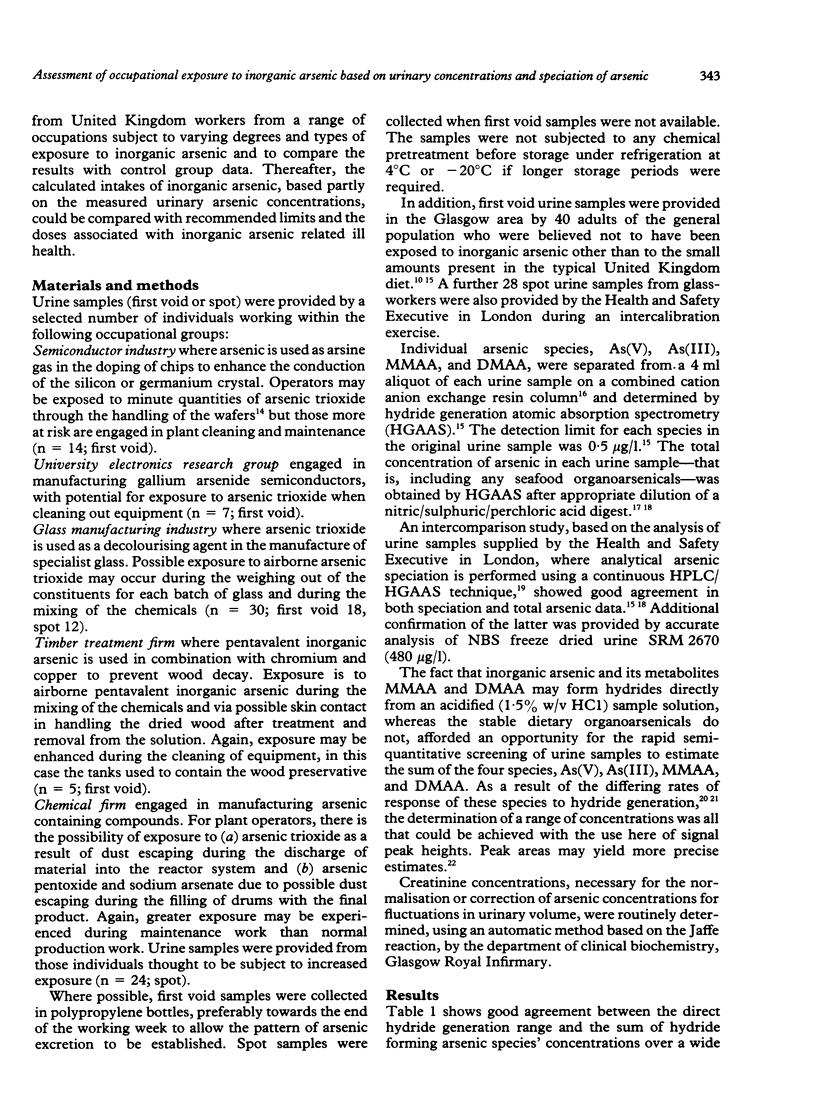
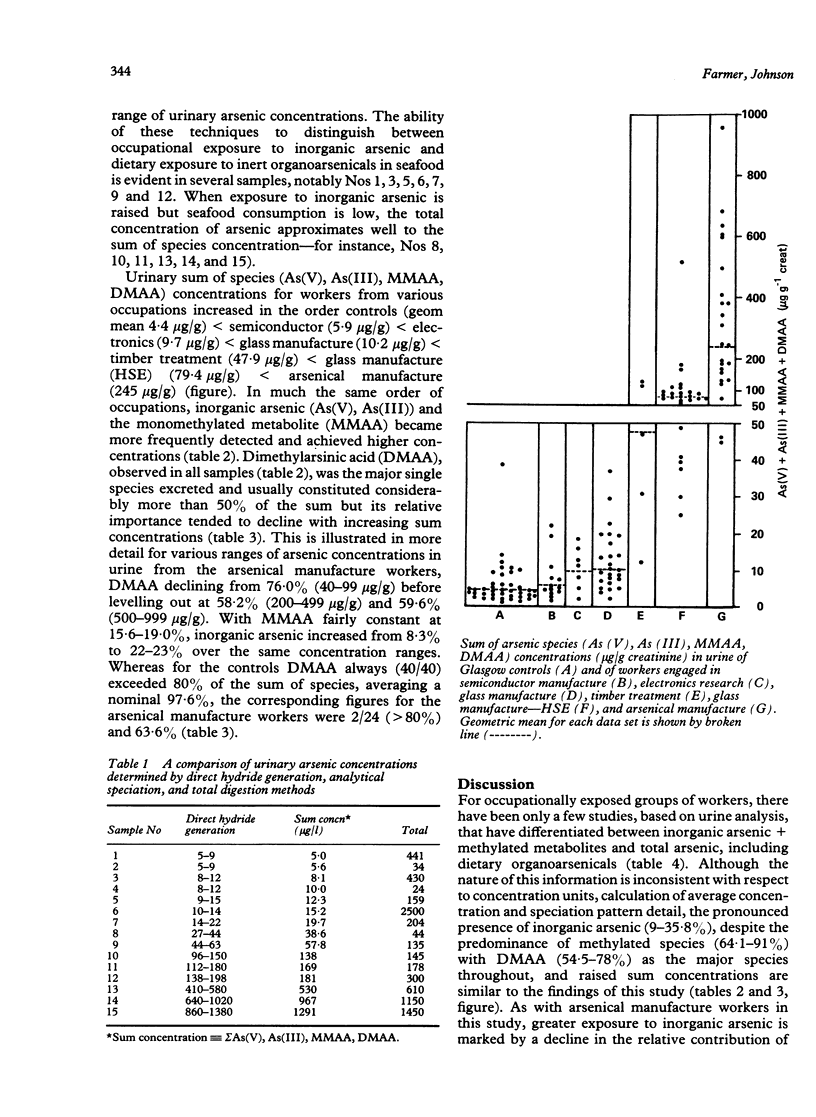
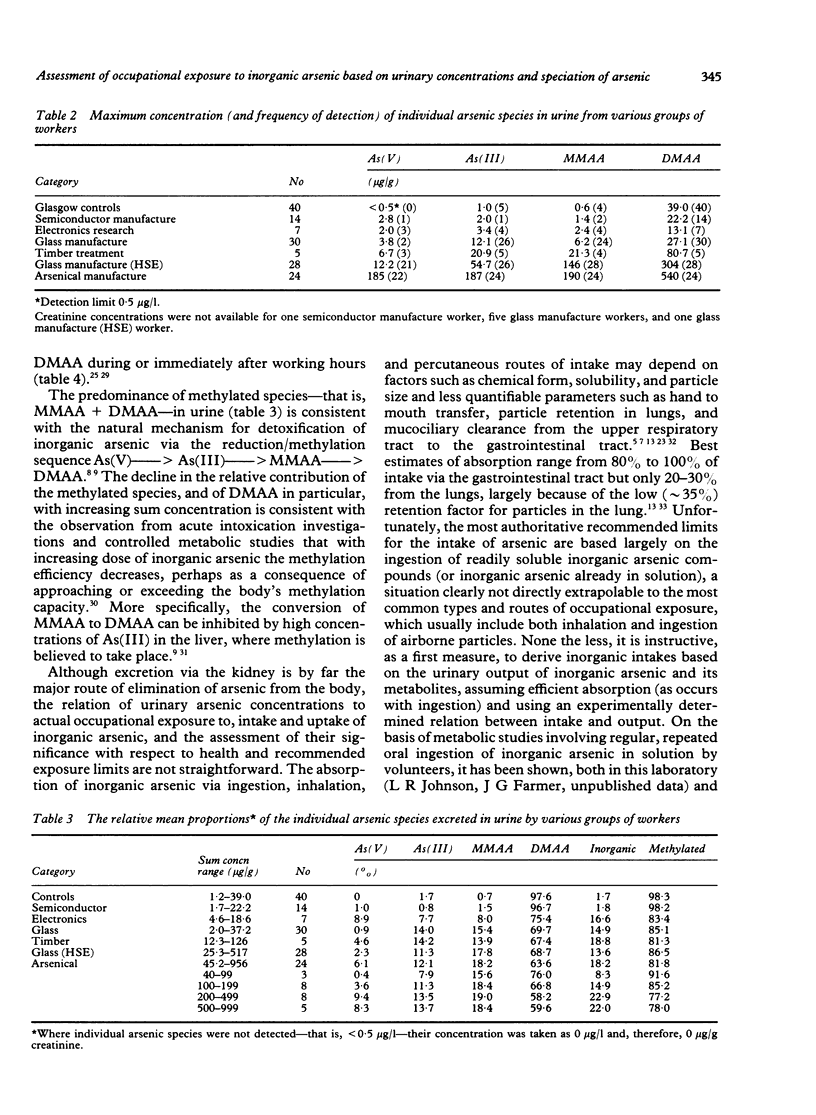
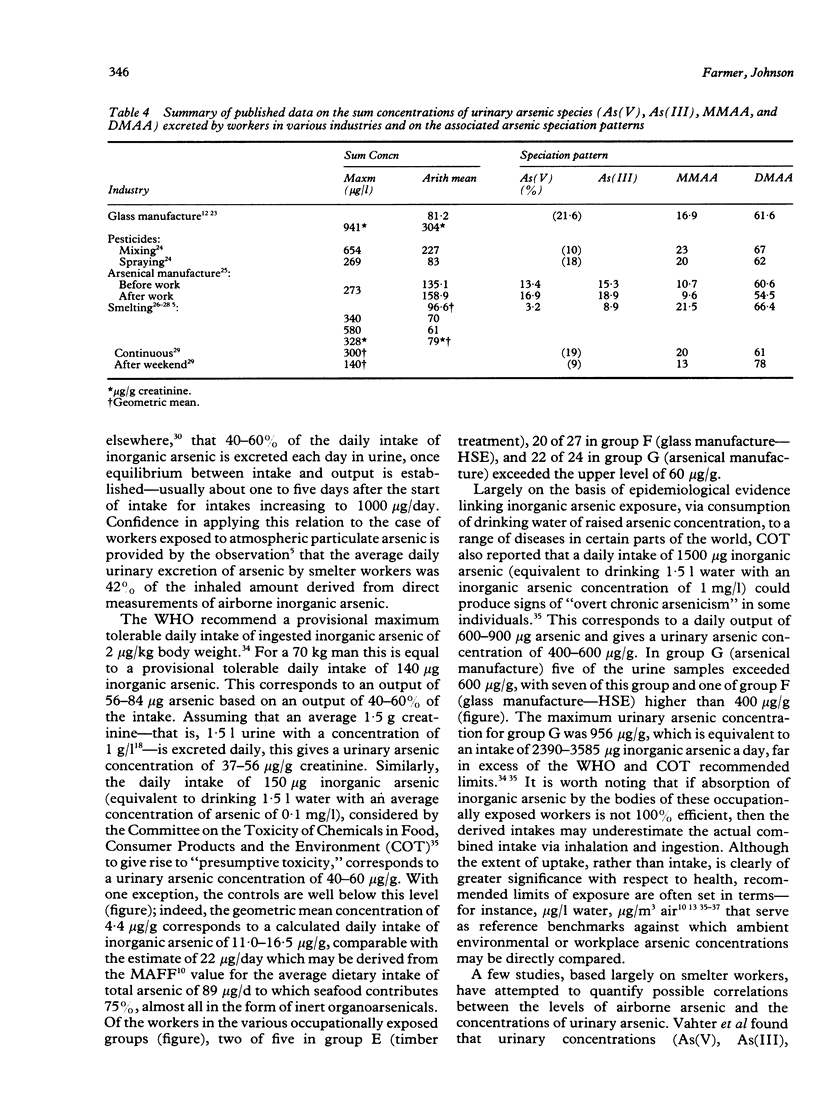
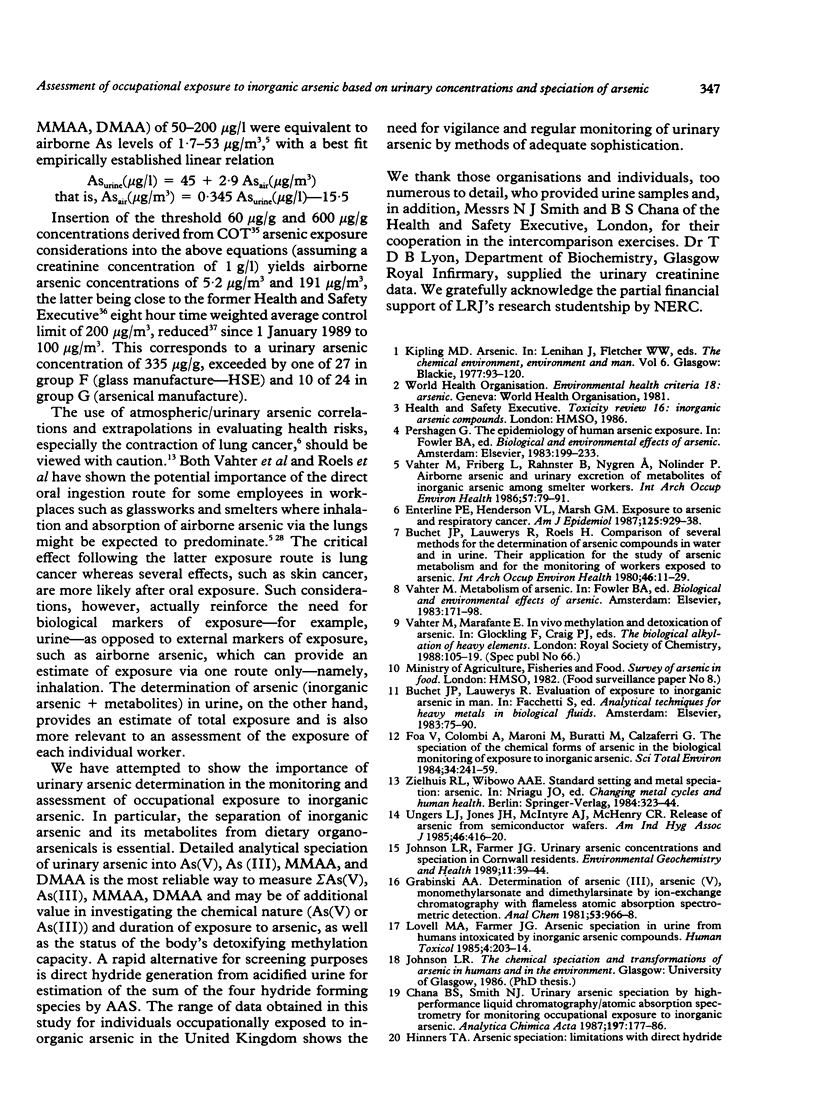
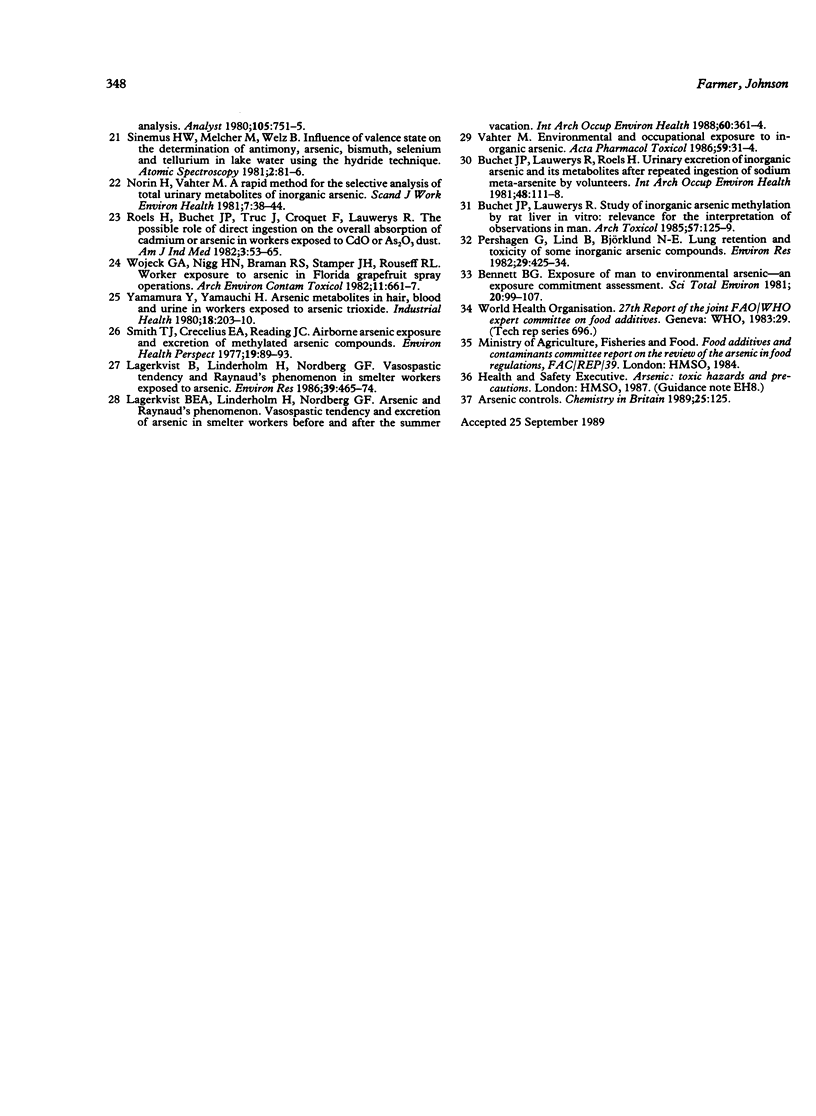
Selected References
These references are in PubMed. This may not be the complete list of references from this article.
- Bennett B. G. Exposure of man to environmental arsenic - an exposure commitment assessment. Sci Total Environ. 1981 Sep;20(2):99–107. doi: 10.1016/0048-9697(81)90056-5. [DOI] [PubMed] [Google Scholar]
- Buchet J. P., Lauwerys R., Roels H. Comparison of several methods for the determination of arsenic compounds in water and in urine. Their application for the study of arsenic metabolism and for the monitoring of workers exposed to arsenic. Int Arch Occup Environ Health. 1980;46(1):11–29. doi: 10.1007/BF00377456. [DOI] [PubMed] [Google Scholar]
- Buchet J. P., Lauwerys R., Roels H. Urinary excretion of inorganic arsenic and its metabolites after repeated ingestion of sodium metaarsenite by volunteers. Int Arch Occup Environ Health. 1981;48(2):111–118. doi: 10.1007/BF00378431. [DOI] [PubMed] [Google Scholar]
- Buchet J. P., Lauwerys R. Study of inorganic arsenic methylation by rat liver in vitro: relevance for the interpretation of observations in man. Arch Toxicol. 1985 Jun;57(2):125–129. doi: 10.1007/BF00343122. [DOI] [PubMed] [Google Scholar]
- Enterline P. E., Henderson V. L., Marsh G. M. Exposure to arsenic and respiratory cancer. A reanalysis. Am J Epidemiol. 1987 Jun;125(6):929–938. doi: 10.1093/oxfordjournals.aje.a114631. [DOI] [PubMed] [Google Scholar]
- Foà V., Colombi A., Maroni M., Buratti M., Calzaferri G. The speciation of the chemical forms of arsenic in the biological monitoring of exposure to inorganic arsenic. Sci Total Environ. 1984 Mar 15;34(3):241–259. doi: 10.1016/0048-9697(84)90066-4. [DOI] [PubMed] [Google Scholar]
- Lagerkvist B. E., Linderholm H., Nordberg G. F. Arsenic and Raynaud's phenomenon. Vasospastic tendency and excretion of arsenic in smelter workers before and after the summer vacation. Int Arch Occup Environ Health. 1988;60(5):361–364. doi: 10.1007/BF00405671. [DOI] [PubMed] [Google Scholar]
- Lagerkvist B., Linderholm H., Nordberg G. F. Vasospastic tendency and Raynaud's phenomenon in smelter workers exposed to arsenic. Environ Res. 1986 Apr;39(2):465–474. doi: 10.1016/s0013-9351(86)80070-6. [DOI] [PubMed] [Google Scholar]
- Lovell M. A., Farmer J. G. Arsenic speciation in urine from humans intoxicated by inorganic arsenic compounds. Hum Toxicol. 1985 Mar;4(2):203–214. doi: 10.1177/096032718500400211. [DOI] [PubMed] [Google Scholar]
- Norin H., Vahter M. A rapid method for the selective analysis of total urinary metabolites of inorganic arsenic. Scand J Work Environ Health. 1981 Mar;7(1):38–44. doi: 10.5271/sjweh.2568. [DOI] [PubMed] [Google Scholar]
- Pershagen G., Lind B., Björklund N. E. Lung retention and toxicity of some inorganic arsenic compounds. Environ Res. 1982 Dec;29(2):425–434. doi: 10.1016/0013-9351(82)90043-3. [DOI] [PubMed] [Google Scholar]
- Roels H., Buchet J. P., Truc J., Croquet F., Lauwerys R. The possible role of direct ingestion on the overall absorption of cadmium or arsenic in workers exposed to CdO or As2O3 dust. Am J Ind Med. 1982;3(1):53–65. doi: 10.1002/ajim.4700030108. [DOI] [PubMed] [Google Scholar]
- Smith T. J., Crecelius E. A., Reading J. C. Airborne arsenic exposure and excretion of methylated arsenic compounds. Environ Health Perspect. 1977 Aug;19:89–93. doi: 10.1289/ehp.771989. [DOI] [PMC free article] [PubMed] [Google Scholar]
- Ungers L. J., Jones J. H., McIntyre A. J., McHenry C. R. Release of arsenic from semiconductor wafers. Am Ind Hyg Assoc J. 1985 Aug;46(8):416–420. doi: 10.1080/15298668591395094. [DOI] [PubMed] [Google Scholar]
- Vahter M. Environmental and occupational exposure to inorganic arsenic. Acta Pharmacol Toxicol (Copenh) 1986;59 (Suppl 7):31–34. doi: 10.1111/j.1600-0773.1986.tb02701.x. [DOI] [PubMed] [Google Scholar]
- Vahter M., Friberg L., Rahnster B., Nygren A., Nolinder P. Airborne arsenic and urinary excretion of metabolites of inorganic arsenic among smelter workers. Int Arch Occup Environ Health. 1986;57(2):79–91. doi: 10.1007/BF00381375. [DOI] [PubMed] [Google Scholar]
- Wojeck G. A., Nigg H. N., Braman R. S., Stamper J. H., Rouseff R. L. Worker exposure to arsenic in Florida grapefruit spray operations. Arch Environ Contam Toxicol. 1982 Nov;11(6):661–667. doi: 10.1007/BF01059152. [DOI] [PubMed] [Google Scholar]
- Yamamura Y., Yamauchi H. Arsenic metabolites in hair, blood and urine in workers exposed to arsenic trioxide. Ind Health. 1980;18(4):203–210. doi: 10.2486/indhealth.18.203. [DOI] [PubMed] [Google Scholar]


